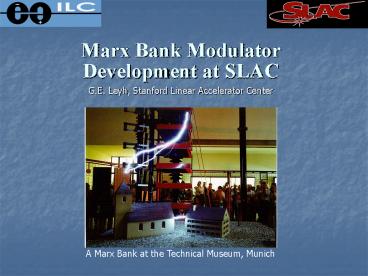Marx Bank Modulator Development at SLAC - PowerPoint PPT Presentation
1 / 20
Title:
Marx Bank Modulator Development at SLAC
Description:
Common-mode chokes provide isolated DC ... Repairs must be fast; modulator ... Faster repair times. G.E. Leyh. ILC Stanford Linear Accelerator Center ... – PowerPoint PPT presentation
Number of Views:137
Avg rating:3.0/5.0
Title: Marx Bank Modulator Development at SLAC
1
Marx Bank ModulatorDevelopment at SLAC
- G.E. Leyh, Stanford Linear Accelerator Center
A Marx Bank at the Technical Museum, Munich
2
Classical Marx Concept
- Developed by Dr. Erwin Marx in the 1920s
- Vout Vin number of cells
- Originally used carbon resistors, spark-gaps
- Design Evolution
- CuSO4 Charging Lines
- Inductive Isolators
- HV Diodes
- Triggered Gaps
- Thyratrons
- Solid State FETs, IGBTs
3
The Solid-State Marx Bank
- NOT a series switch Diodes provide parallel
path - Each cell can switch on/off independently
- Staged firing of cells allows contouring of pulse
shape - Common-mode chokes provide isolated DC power
4
SLAC 500kV NLC Marx Concept
circa 2003
- Total stack output 500kV, 550A
- 30 Marx blocks total, 18kV per block
- Commercial 2.4Ghz RF chipsets
- no wires or fiber-optic cables
5
500kV NLC Marx Cell Components
circa 2003
6
500kV Marx Block Waveforms
circa 2003
7
From NLC to ILC Modulator Requirements
NLC ILC
Pulse Voltage Pulse Current Pulse Length
flat-top Total Pulse Charge Total Pulse
Energy Repetition Rate Average Output Power Total
of Stations
500 kV 120 kV 550 A 140 A 1.6 uS 1370 uS 0.88
mC 192 mC 440 J 23,000 J 120 Hz 5 Hz 53 kW 115
kW 1600 576
8
Existing 10MW TTF Modulator
- Developed in the early 90s at FermiLab for use
with the TTF. - Currently in use at FNAL and on the XFEL at DESY.
- Uses a passive bouncer circuit to compensate
for capacitor droop. - Advantages
- Simple circuit topology
- Proven design 10 years of operation
- Disadvantages
- High stored energy 270kJ
- Massive pulse transformer 6.5 tons
- Single-point failures can damage klystron
- Requires large floor area
- Insulating oil 100s of gallons
9
Solid State Marx ModulatorPros and Cons
- Lower IGBT currents
- No magnetic core issues
- losses
- core reset
- acoustic noise
- core saturation
- leakage inductance
- magnetizing currents
- PC board integration
- Mechanically simple, more compact
- Finer waveform control
- IGBT controls float at high voltage during pulse
- DC power flow to cells must be isolated
- Timing signals must cross high voltage gradients
10
ILC Marx Design Approach
NLC Marx
ILC Marx
- Inductive isolation of DC not practical for long
pulse use solid-state switches - Cell capacitors must be substantially larger
- Active regulation required to maintain pulse
flatness
11
Integrated Charging Regulator / Cell Isolator
- Single IGBT switch performs charging regulation
and cell isolation functions - A simple fusible link isolates cells in the event
of a short circuit fault - Dual mode charger converts from current mode to
voltage mode upon reaching setpoint - Control power provided to each cell through a low
current diode stack - Cells charge in sequence, starting at the bottom
12
Availability ILC Modulator Considerations
MTBF
Availability
MTBF MTTR
Number of required modulator stations
560 Number of available modulator stations
576 Required steady-state modulator
availability 99.3
Increase MTBF
- Minimize possibilities of single-point failures
- Modulator must automatically work around
failures
Decrease MTTR
- Repairs must be fast modulator identifies bad
cells - Partition stored energy, to isolate catastrophic
failures
13
ILC Marx Design Approach
- Use emerging technology
- High ohm/sq explosion-proof capacitors
- 4500V single-die IGBTs
- Commercial RF chipsets for signal paths
- Avoid transformer oil, controlled materials
- Closed-circuit air cooling, exchanged with LCW
- Modular mechanical design
- Simpler mechanical solution, more compact
- Lower construction costs
- Faster repair times
14
12kV Solid-State IGBT Switch
- 5-section modular PC-board design, using 4500V
Single-Die IGBTs - Each section has independent gate drivers, delay
stabilization circuitry, overvoltage protection
and snubbing networks - Switch designed to operate at full spec with one
failed section - Overcurrent protection with multiple
threshold/delay setpoints
15
ILC Marx Cell Module Layout
16
ILC Marx Modulator Core Layout
17
Air Cooling State of the Art
18
Prototype Development Approach
- Start with the highest technical risk items
12kV switch, energy storage capacitors. - Assemble, test, debug a complete cell.
- Work towards developing a short stack.
- Explore stack-level fault scenarios.
- Design, test the active regulation control loop.
- Develop complete modulator, control system, RF
station. Integrate with L-Band klystron.
19
Marx Prototype Schedule
- Test 12kV switch module performance May 05
- Evaluate cell components May 05
- Integrate, test completed Marx cell Aug 05
- Start active control system design Sep 05
- Marx short stack ready for evaluation Nov 05
- Integrate short stack, control system Dec 06
- Short stack fault scenario testing complete Feb
06 - Start construction of full modulator stack Mar 06
- Marx modulator ready for klystron connection Oct
06
20
Current Status 24 Mar 05
- 12kV Switch v1.0
- Design 60 complete
- Assembly 20 complete
- Capacitors
- First engineering samples have arrived
- Lifetime testing to start in a few weeks
- ILC Marx Test Area
- Design 80 complete
- Assembly 10 complete































